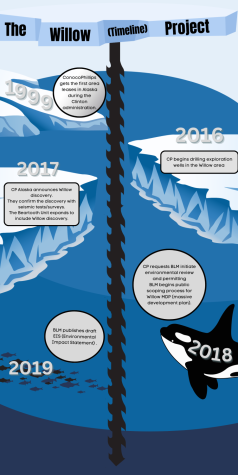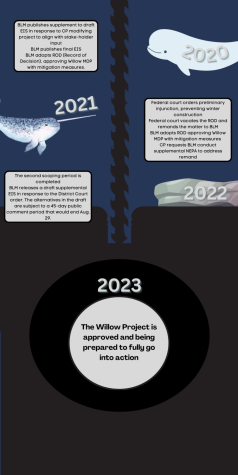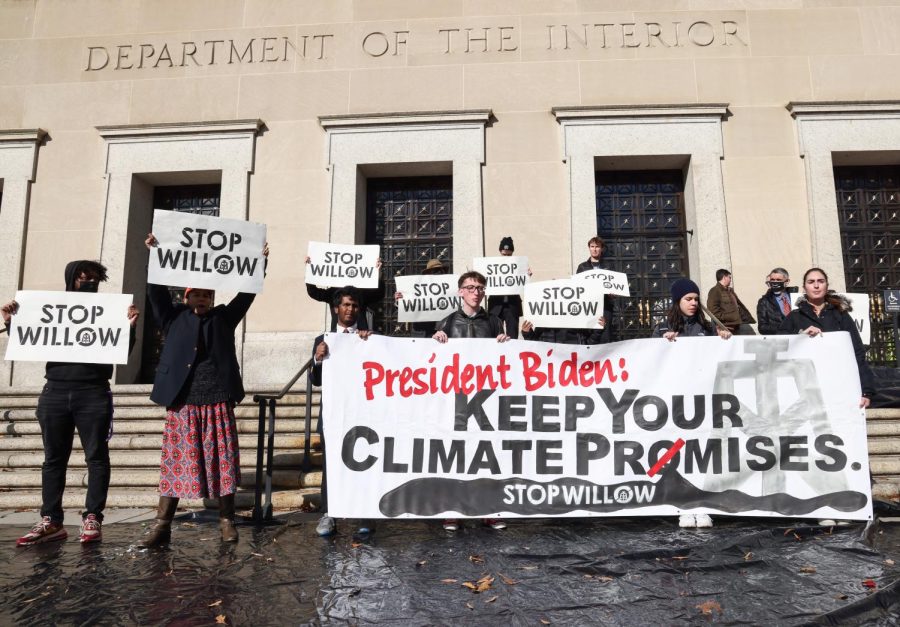The Willow Project
On Nov 17, 2022, Climate activists hold protest to urge President Biden to reject the Willow Project at the US Department of Interior in Washington, DC; Credits by Jemal Countess 2022 Getty Images
May 10, 2023
“We are in the beginning of a mass extinction, and all you can talk about is money and fairy tales of eternal economic growth. How dare you!”
-Greta Thunberg
Concern for the environment has steadily grown over the years, becoming more controversial as time passes. With the recent approval of the Willow Project, debates over environmental protection have worsened. The Willow Project, ratified by the Biden administration on Mar. 13, 2023, is a drilling venture in Alaska. Its ratification was surprising, given President Joe Biden’s campaign promise to advocate for nature. While his administration labels the project as economically beneficial, it may have significantly negative consequences on both the environment and people around the world.
The Willow Project was originally proposed by ConocoPhillips in 1999. The company acquired the first area leases in the Teshekpuk Lake Special Area, AK under the Clinton administration but was not yet a popular or controversial topic. The project was put on hold for years due to constant legal and ethical issues. For instance, the idea of having five drill site pads had to be changed after the Record of Decision denied two of them. Another troubling part of its development is that part of the drilling takes place in the BearTooth Unit, a space specifically made to “maintain plants and wildlife such as elk, bighorn sheep, and mule deer.”
After beginning drilling in 2016, ConocoPhillips announced the discovery of oil in the Willow area. They conducted seismic tests, which use high-powered air to map oil or gas reserves, and confirmed the discovery. Two years later, the Bureau of Land Management (BLM) began the scoping process of the development plan for an environmental review. They concluded that it was “environmentally-just” and will benefit those in need of work.
The BLM later released the Environmental Impact Statement in 2020. This document stated a preferred alternative due to the various environmental concerns. They also adopted the Record of Decision which approved the Willow Project with mitigation measures. The project would fully be approved in 2023 by the Biden administration.


The morality of the Willow Project has since been a popular debate, especially between the Republican and Democratic parties. This is mostly seen in two news sources famous for their right or left-leaning tendencies: Fox News and CNN.
On Mar. 13, 2023, Fox hosted an interview with Alaskan Republican Senator Dan Sullivan, who is in complete support of the project. Sullivan says, “It’s really great for American workers, right? 2500 jobs is the estimate.” The main argument of those in agreement with the drilling is that it will provide many jobs to people in need of work. However, Sullivan mentions that there is also a political aspect to it. He says, “American power is American energy. Xi Jinping and Putin fear it.” The U.S. has a long history of competition and conflict with China and Russia, which explains the apparent ongoing need to show that they have more power. When asked about the thoughts of Alaskan natives, Sullivan says, “The native community supported it very strongly in our state.”
The BLM released the official 2023 Record of Decision document on March 13, 2023, the day the Willow Project was approved, which includes sections that address common questions or concerns. Under the “Evaluation and Consideration of Comments Received” section, it says that over half of the comments fall under “mitigation or minimization, climate change, request for extension or for no extension of public comment period, alternatives, cumulative effects, marine mammals, and EIS process/timeline.”
While this is true for some natives, the senator doesn’t speak for all Alaskan natives. Many are worried about how the Willow Project will impact wildlife and the world around them.
Nuiqsut Mayor Rosemary Ahtuangaruak says, “Our people feed their families with traditional subsistence activities like fishing and hunting caribou, moose, birds, and more. The Willow Project’s massive infrastructure would bulldoze straight through these crucial habitats…” Apart from the air pollution it will cause, natives are concerned with how this will change day-to-day life for them. The destruction of the habitats for these animals will cause migratory changes, eventually making them scarce.
CNN is more concerned with the impact on climate change than the effect the Willow Project will have on the economy. Ella Nilson, the journalist who wrote an article concerning the approval of it, mentions how ConocoPhillips’ administration estimated that the drilling would release the “equivalent to adding 2 million gas-powered cars to the roads” of carbon pollution. There is also much criticism of Biden.
Jeremy Lieb, an attorney in environmental law group Earth Justice, says, “This is a huge climate threat and inconsistent with this administration’s promises to take on the climate crisis.”
In a 2020 debate, Biden said, “No more subsidies for fossil fuel industry. No more drilling on federal lands. No more drilling, including offshore. No ability for the oil industry to continue to drill…” His advocacy for the environment was likely a major reason why Alaska’s democratic vote spiked for the first time since the 1964 presidential election.
Although we understand the opportunities the Willow Project can bring for those in need of work, we strongly oppose its approval. Though this drilling venture may provide jobs, oil, and gasoline, the possibility of massive oil spills in the waters of Alaska–where many already endangered species take refuge–is too high of a risk for a meager 2500 jobs. In the end, the Willow project will not just affect Alaska but the entire Earth, and only when there is no world to live in will people realize that there is a much bigger issue at hand than money.


























